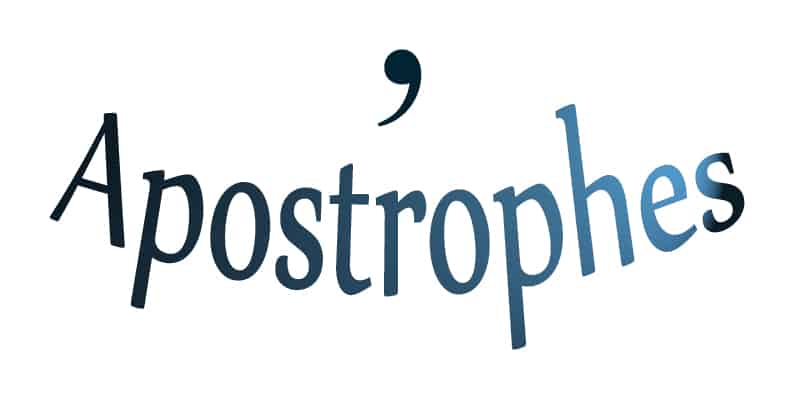
Today, we’ll be talking about apostrophes, when to use them with omitted letters and possessives, and which way they should face. A few simple rules will help you use apostrophes with confidence.
How to Use Apostrophes in Contractions
In contractions or partial words, the apostrophe takes the place of the missing letters.
they’re = they are
I’m = I am
It’s = it is
don’t = do not
wasn’t = was not
Unlike single quotation marks, apostrophes should always curve to the left.
Right:  = them
= them
Wrong:  = them
= them
Microsoft Word will always put in the apostrophe so that it curves toward the text, which, in the example above, would be the wrong way. The best way to fix these errors is to run a search and replace for words you know are in your book. For example, you could put ‘em into the Find box and ’em into the Replace box.
How to Use Apostrophes in Possessives
Apostrophes are also used in possessives. The basic rule is to add ’s, whether the noun is singular or plural.
Claire’s book
Nate’s book
The children’s book
One exception to adding ’s is with the word it. In this case, you do NOT include an apostrophe.
Right: Its book
Wrong: It’s book (this means “It is book” not that the book belong to “It.”)
When the noun ends in an s (and is singular), you still add an ’s.
For the name James:
Right: James’s book
Wrong: James’ book
The Chicago Manual of Style used to recommend omitting that extra “s” in the names of Biblical figures, such as Jesus and Moses, but it has since removed that exception for consistency’s sake. However, Merriam-Webster’s Dictionary, as well as several style guides, still recommends omitting the extra “s.”
Merriam-Webster: Jesus’ book.
Chicago: Jesus’s book.
For the word class:
Right: The class’s pet
Wrong: The class’ pet
When the noun ends in an s and is plural, you only add an apostrophe.
For the name Jones (the plural is Joneses, as in “The Joneses”):
Right: The Joneses’ place
Wrong: The Joneses’s place
For the word classes:
Right: The classes’ party
Wrong: The classes’s party
Apostrophes to Make Plurals
In general, apostrophes are not used to make plurals. One exception is when making single letters plural. (Note: other exceptions are when NOT using the apostrophe would make the sentence unclear.)
Right: Mind your p’s and q’s.
Wrong: Mind your ps and qs.
Right: There are two a’s in that word.
Wrong: There are two as in that word.
If you’d like to learn more about Book Cave author promotions or other punctuation tips like these, please enter your email below and click the “Learn More” button to receive our author newsletter.










Hi Catia
I have written 8 funny novels and would like to thank you for your advice on contractions or partial words, when writing ’em with curved apostrophes.
However you say, ‘you could put ‘em into the Find box and ’em into the Replace box.’ This doesn’t work for me. I have to go through the document and change each right curving apostrophe to a left curving apostrophe in turn. Am I missing a trick?.
Note: Word seems to put straight apostrophes in at random, but this can be easily sorted by Find and Replace.
Any help much appreciated.
Kind Regards
Stan Arnold
Ah yes, Word has gotten “smarter” about “fixing” quote marks. You’ll need to turn off the smart quote autoCorrect, then replace the quotes, then turn it back on.
On a PC, click on the File tab, then click Options, then Proofing, then AutoCorrect Options. In the AutoCorrect dialog box, click the AutoFormat As You Type tab, and under Replace as you type, uncheck the “Straight quotes” with “smart quotes” box.
On a Mac, click on the Tools menu, then AutoCorrect Options, then the AutoFormat as You Type tab, and then under the Automatically as you type section, uncheck the “Straight quotes” with “smart quotes” box.
Then be sure to check it again once you’ve made your replacements.
Would you care to comment on the 60’s versus the 60s? Help the world get the placement of the apostrophe in such cases straight, please!
Part of the confusion stems from the style guide, since different style guides recommend different uses. Authors of novels should be using The Chicago Manual of Style, though, and Chicago recommends NOT using the apostrophe in this case.
Examples:
The 1960s were great!
The ’60s were great (an apostrophe is needed before the numbers to show the missing numbers)
But keep in mind that an apostrophe IS needed if it’s a specific year that is possessive.
For example: 1962’s biggest snowstorm dropped 10 feet of snow.
The Oakland A’s is the example people always point to and say, “see, there’s an apostrophe.” I wearily tell them the history of that naming, even knowing I’ll feel like a pedant for the rest of the day…
One final note: How about this phrase: “Jagger, the quintessential 60’s rock star…” or “Jagger, the quintessential 60s’ rock star…” Funny one, isn’t it?
Just found this example in a newspaper comments section: “And to be fair it was a 1940’s view which was post independence…” Shouldn’t the apostrophe come after the s, “a 1940s’ view…”? But that does look a bit weird, huh.
Another note, though. Chicago recommends spelling out decades rather than using numerals:
The sixties were great!
Leave a Reply
Patience has a book,add the apostrophe
It would be “Patience’s book.”